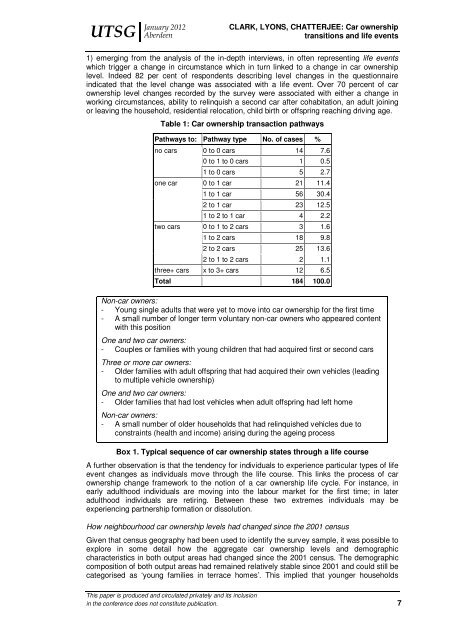Clark, B., Lyons, G. and Chatterjee, K. (2012) - UWE Research ...
Clark, B., Lyons, G. and Chatterjee, K. (2012) - UWE Research ...
Clark, B., Lyons, G. and Chatterjee, K. (2012) - UWE Research ...
Create successful ePaper yourself
Turn your PDF publications into a flip-book with our unique Google optimized e-Paper software.
UTSG<br />
January <strong>2012</strong><br />
Aberdeen<br />
CLARK, LYONS, CHATTERJEE: Car ownership<br />
transitions <strong>and</strong> life events<br />
1) emerging from the analysis of the in-depth interviews, in often representing life events<br />
which trigger a change in circumstance which in turn linked to a change in car ownership<br />
level. Indeed 82 per cent of respondents describing level changes in the questionnaire<br />
indicated that the level change was associated with a life event. Over 70 percent of car<br />
ownership level changes recorded by the survey were associated with either a change in<br />
working circumstances, ability to relinquish a second car after cohabitation, an adult joining<br />
or leaving the household, residential relocation, child birth or offspring reaching driving age.<br />
-<br />
Table 1: Car ownership transaction pathways<br />
Pathways to: Pathway type No. of cases %<br />
no cars<br />
one car<br />
two cars<br />
0 to 0 cars 14 7.6<br />
0 to 1 to 0 cars 1 0.5<br />
1 to 0 cars 5 2.7<br />
0 to 1 car 21 11.4<br />
1 to 1 car 56 30.4<br />
2 to 1 car 23 12.5<br />
1 to 2 to 1 car 4 2.2<br />
0 to 1 to 2 cars 3 1.6<br />
1 to 2 cars 18 9.8<br />
2 to 2 cars 25 13.6<br />
2 to 1 to 2 cars 2 1.1<br />
three+ cars x to 3+ cars 12 6.5<br />
Total 184 100.0<br />
Non-car owners:<br />
- Young single adults that were yet to move into car ownership for the first time<br />
- A small number of longer term voluntary non-car owners who appeared content<br />
with this position<br />
One <strong>and</strong> two car owners:<br />
- Couples or families with young children that had acquired first or second cars<br />
Three or more car owners:<br />
- Older families with adult offspring that had acquired their own vehicles (leading<br />
to multiple vehicle ownership)<br />
One <strong>and</strong> two car owners:<br />
- Older families that had lost vehicles when adult offspring had left home<br />
Non-car owners:<br />
- A small number of older households that had relinquished vehicles due to<br />
constraints (health <strong>and</strong> income) arising during the ageing process<br />
Box 1. Typical sequence of car ownership states through a life course<br />
A further observation is that the tendency for individuals to experience particular types of life<br />
event changes as individuals move through the life course. This links the process of car<br />
ownership change framework to the notion of a car ownership life cycle. For instance, in<br />
early adulthood individuals are moving into the labour market for the first time; in later<br />
adulthood individuals are retiring. Between these two extremes individuals may be<br />
experiencing partnership formation or dissolution.<br />
How neighbourhood car ownership levels had changed since the 2001 census<br />
Given that census geography had been used to identify the survey sample, it was possible to<br />
explore in some detail how the aggregate car ownership levels <strong>and</strong> demographic<br />
characteristics in both output areas had changed since the 2001 census. The demographic<br />
composition of both output areas had remained relatively stable since 2001 <strong>and</strong> could still be<br />
categorised as ‘young families in terrace homes’. This implied that younger households<br />
This paper is produced <strong>and</strong> circulated privately <strong>and</strong> its inclusion<br />
in the conference does not constitute publication. 7

















